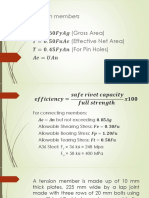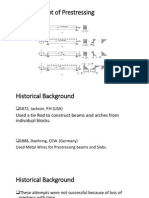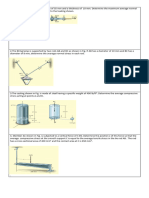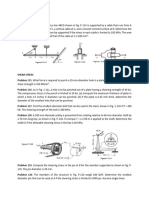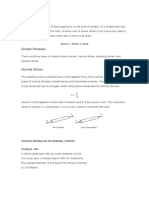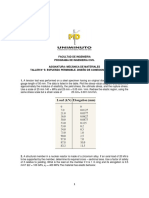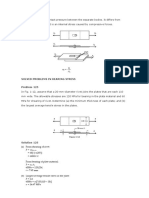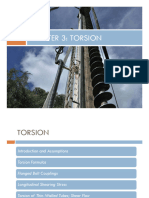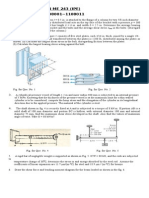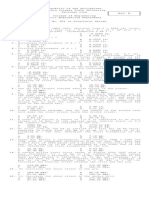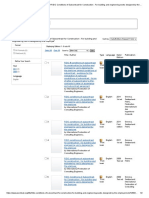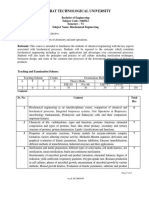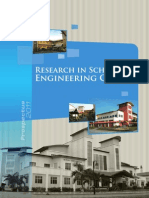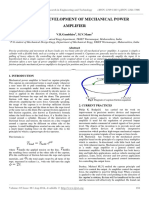Solid Tutorial 7
Solid Tutorial 7
Uploaded by
Mohammad Afandi Azmi RaifCopyright:
Available Formats
Solid Tutorial 7
Solid Tutorial 7
Uploaded by
Mohammad Afandi Azmi RaifCopyright
Available Formats
Share this document
Did you find this document useful?
Is this content inappropriate?
Copyright:
Available Formats
Solid Tutorial 7
Solid Tutorial 7
Uploaded by
Mohammad Afandi Azmi RaifCopyright:
Available Formats
1. A spherical gas tank has an inner radius of r = 1.5 m.
If it is subjected to an internal pressure of p = 300 kPa, determine its required thickness if the maximum normal stress is not to exceed 12 MPa.
2. The tank of the air compressor is subjected to an internal pressure of 0.63 MPa. If the internal diameter of the tank is 550 mm, and the wall thickness is 6 mm, determine the stress components acting at point A. Draw a volume element of the material at this point, and show the results on the element.
3. The cap on the cylindrical tank is bolted to the tank along the flanges. The tank has an inner diameter of 1.5 m and a wall thickness of 18 mm. If the largest normal stress is not to exceed 150 MPa, determine the maximum pressure the tank can sustain. Also, compute the number of bolts required to attach the cap to the tank if each bolt has a diameter of 20 mm. The allowable stress for the bolts is (allow)b = 180 MPa.
4. The steel bracket is used to connect the ends of two cables. If the allowable normal stress for the steel is allow = 168 MPa, determine the largest tensile force P that can be applied to the cables. The bracket has a thickness of 12 mm and a width of 18 mm.
5. The vertical force P acts on the bottom of the plate having a negligible weight. Determine the maximum distance d to the edge of the plate at which it can be applied so that it produces no compressive stresses on the plate at section a-a. The plate has a thickness of 10 mm and P acts along the centerline of this thickness.
6. The bar has a diameter of 40 mm. If it is subjected to a force of 800 N as shown, determine the stress components that act at point A and show the results on a volume element located at this point.
7. Since concrete can support little or no tension, this problem can be avoided by using wires or rods to prestress the concrete once it is formed. Consider the simply supported beam shown, which has a rectangular cross section of 450 mm by 300 mm. If concrete has a specific weight of 24 kN/m3, determine the required tension in rod AB, which runs through the beam so that no tensile stress is developed in the concrete at its center section a-a. Neglect the size of the rod and any deflection of the beam.
8. The wide-flange beam is subjected to the loading shown. Determine the stress components at points A and B and show the results on a volume element at each of these points. Use the shear formula to compute the shear stress.
9. The masonry pier is subjected to the 800-kN load. If x = 0.25 m and y = 0.5 m, determine the normal stress at each corner A, B, C, D (not shown) and plot the stress distribution over the cross section. Neglect the weight of the pier.
You might also like
- Method Statement - Piling WorkDocument7 pagesMethod Statement - Piling WorkLook100% (1)
- BotlsDocument32 pagesBotlsJohn Lancer FabonNo ratings yet
- Strength of Materials, 4th Edition (Solutions Manual) - Singer, PytelDocument286 pagesStrength of Materials, 4th Edition (Solutions Manual) - Singer, PytelSamantha CusiNo ratings yet
- (IEEE) Evolution of IEC 60826 Loading and Strength of Overhead LinesDocument15 pages(IEEE) Evolution of IEC 60826 Loading and Strength of Overhead LinesIvan Herrera100% (2)
- The Osim GroupDocument14 pagesThe Osim Group0asdf4No ratings yet
- Chapter 1Document38 pagesChapter 1Abdullah SimpsonNo ratings yet
- Es 07 ExamsDocument8 pagesEs 07 Examsbernardhanskurt.mortilNo ratings yet
- Strength of Materials PDFDocument35 pagesStrength of Materials PDFromeo08100% (1)
- Es 07 ExamsDocument9 pagesEs 07 Examsbernardhanskurt.mortilNo ratings yet
- BearingDocument28 pagesBearingGilbert Caesar Fermin Jr.No ratings yet
- Simple Stresses 1Document21 pagesSimple Stresses 1Midas Troy VictorNo ratings yet
- Tugas 1 (Allowable Stress)Document5 pagesTugas 1 (Allowable Stress)WAHYU DWI LESTARINo ratings yet
- HandoutsDocument3 pagesHandoutssheena Marjorie Cabidog100% (1)
- Mechanics of Deformable Bodies - Supplementary ProblemsDocument7 pagesMechanics of Deformable Bodies - Supplementary ProblemsDhenil ManubatNo ratings yet
- Lecture On Strength of Materials August 2014Document87 pagesLecture On Strength of Materials August 2014Cha Castillo100% (2)
- Department of Mechanical Engineering ME-311, Fundamentals of Machine Design Assignment Sheet No.1 1Document6 pagesDepartment of Mechanical Engineering ME-311, Fundamentals of Machine Design Assignment Sheet No.1 1VishnuNo ratings yet
- CE224 MDB - Module 1: StressDocument8 pagesCE224 MDB - Module 1: Stressaileen eustaquioNo ratings yet
- Mechanics of Deformable Bodies Review ProblemsDocument7 pagesMechanics of Deformable Bodies Review ProblemsadrianNo ratings yet
- ShearDocument6 pagesShearGilbert Caesar Fermin Jr.No ratings yet
- Concepts of Stress1 PDFDocument18 pagesConcepts of Stress1 PDFCarl Malone Lotivio LorillaNo ratings yet
- Strength of MaterialsDocument10 pagesStrength of MaterialsChristian Joseph R. GonzalesNo ratings yet
- MEC03-PROBLEMSDocument12 pagesMEC03-PROBLEMSjbmlucilaNo ratings yet
- Deform Pset AnswersDocument11 pagesDeform Pset AnswersUragon's gamingNo ratings yet
- Assignment # 2FDocument9 pagesAssignment # 2FCrisnico PeligrinoNo ratings yet
- Normal Stress Stress: Simple StressesDocument24 pagesNormal Stress Stress: Simple StressesJake Tuwa MiguelNo ratings yet
- 5.2 Taller #5 Esfuerzo Permisible. Diseño de Conexiones SimplesDocument6 pages5.2 Taller #5 Esfuerzo Permisible. Diseño de Conexiones SimplesCamilo HernandezNo ratings yet
- Strength of MaterialsDocument18 pagesStrength of MaterialsRuth Abegail de VeraNo ratings yet
- Bearing & Thin WalledDocument17 pagesBearing & Thin WalledEmjay SevillaNo ratings yet
- Simple Stresses1st.24 25Document41 pagesSimple Stresses1st.24 25zed santosNo ratings yet
- Torsion and PowerDocument17 pagesTorsion and PowerMariscotes Jam Jr.No ratings yet
- Strength of Materials: Prepared By: Engr. Jeric P. SarteDocument30 pagesStrength of Materials: Prepared By: Engr. Jeric P. SarteGiacomo EllieNo ratings yet
- The Truss Shown Carries A Weight W 500N. Find The Tensile Stress (Mpa) in Member Ac If It Has A Diameter of 8MmDocument23 pagesThe Truss Shown Carries A Weight W 500N. Find The Tensile Stress (Mpa) in Member Ac If It Has A Diameter of 8MmpamelaNo ratings yet
- Assignment For IPEDocument4 pagesAssignment For IPEAbirHasanNo ratings yet
- Mec03-Problems (Stress and Strain)Document11 pagesMec03-Problems (Stress and Strain)Benedict Lucila100% (1)
- Exercise 5 PDFDocument4 pagesExercise 5 PDFchetanNo ratings yet
- Exercise 5 PDFDocument4 pagesExercise 5 PDFAvinash IyerNo ratings yet
- ME102: Engineering Mechanics Homework #7Document3 pagesME102: Engineering Mechanics Homework #7RahulAggarwalNo ratings yet
- Strength of Materials - Task 1. Chapter 4-IiDocument4 pagesStrength of Materials - Task 1. Chapter 4-IiMilton CobaNo ratings yet
- Strength of MaterialsDocument11 pagesStrength of Materialsjerold_arandiaNo ratings yet
- Module 1 - Solved ProblemsDocument12 pagesModule 1 - Solved ProblemsRhenz Ashley AdemNo ratings yet
- Tutorial 1 Concept of StressDocument3 pagesTutorial 1 Concept of Stresswilliamgacc11No ratings yet
- MD1 Chapter1Document8 pagesMD1 Chapter1JH PerlasNo ratings yet
- Tutorial 6 PDFDocument3 pagesTutorial 6 PDFSaketh BoggavarapuNo ratings yet
- CE22S CE BSC 232b Activity 1 StressDocument2 pagesCE22S CE BSC 232b Activity 1 StressJoshua John JulioNo ratings yet
- Pure BendingDocument4 pagesPure BendingSanthoshRockzzNo ratings yet
- Unit - 1Document8 pagesUnit - 1Dhileepan KumarasamyNo ratings yet
- Tutorials 2Document3 pagesTutorials 2Daemaro Liv Guud BremmerNo ratings yet
- 05.1 Flanged Bolt Couplings Torsion in Thin Walled Tubes Helical SpringsDocument37 pages05.1 Flanged Bolt Couplings Torsion in Thin Walled Tubes Helical SpringsRoséyNo ratings yet
- Exercise 1Document6 pagesExercise 1JVM CegueraNo ratings yet
- Strength of Materials - Shear StressesDocument2 pagesStrength of Materials - Shear StressesJan Alexis Monsalud0% (1)
- Smat Quiz BeesDocument9 pagesSmat Quiz BeesJayson IsidroNo ratings yet
- Fig. P3.129, P3.130Document4 pagesFig. P3.129, P3.130Alen RustemovicNo ratings yet
- Ans. σ = 70 psi; τ = 40.4 psi: ExercisesDocument2 pagesAns. σ = 70 psi; τ = 40.4 psi: ExercisesJasleneDimarananNo ratings yet
- SOM AssignmentDocument6 pagesSOM Assignmentshreyas shahNo ratings yet
- Mechanics Prob 2Document3 pagesMechanics Prob 2Paul Angelou CiriacoNo ratings yet
- Chapter 1 - Simple StressesDocument39 pagesChapter 1 - Simple StressesJovy Notorio100% (2)
- Quiz No 1 - Set D PDFDocument2 pagesQuiz No 1 - Set D PDFMayoune Nasinopa GalvezNo ratings yet
- StrengthDocument101 pagesStrengthSigue Ramel Hinayas0% (1)
- Strength of Material Lecture ProblemsDocument11 pagesStrength of Material Lecture ProblemsLorenz ArdienteNo ratings yet
- Problem Set 1Document7 pagesProblem Set 1Percival ArcherNo ratings yet
- Prelim Emt313nDocument9 pagesPrelim Emt313npaulineNo ratings yet
- Theories of Failure PresentationDocument10 pagesTheories of Failure PresentationSiddabathula MaheshNo ratings yet
- Microsoft Word MecvinaDocument37 pagesMicrosoft Word MecvinaRam RamirezNo ratings yet
- Test Plan TemplateDocument4 pagesTest Plan TemplaterajeshjhajhraNo ratings yet
- Makaut Form PDFDocument1 pageMakaut Form PDFSwaagato ChakrabortyNo ratings yet
- TTEC Underground Installations ManualDocument148 pagesTTEC Underground Installations ManualWilliamNo ratings yet
- Advanced Search Find A Library Return To Item Details: Engineering Works Designed by The Employer'Document2 pagesAdvanced Search Find A Library Return To Item Details: Engineering Works Designed by The Employer'Rathnayaka NewilNo ratings yet
- 01-Checklist For Excavation To BackfillingDocument2 pages01-Checklist For Excavation To Backfillingmd_rehan_2No ratings yet
- Professional Resume (English)Document5 pagesProfessional Resume (English)Ahmadreza AminianNo ratings yet
- Preview Form 2019-2023 CseDocument237 pagesPreview Form 2019-2023 CsetskesavanNo ratings yet
- Manarin IECEP ConventionDocument13 pagesManarin IECEP ConventionMae ConstantinoNo ratings yet
- Student Handbook EE200 Pindaan Julai 2020Document32 pagesStudent Handbook EE200 Pindaan Julai 2020Nuha NajihahNo ratings yet
- Biochemical Engineering Solutions Manual For Rajiv Dutta PDFDocument2 pagesBiochemical Engineering Solutions Manual For Rajiv Dutta PDFMatheus MancinoNo ratings yet
- 1756 TBCH DatasheetDocument1 page1756 TBCH Datasheet朱迎安No ratings yet
- Gujarat Technological University: W.E.F. AY 2018-19Document3 pagesGujarat Technological University: W.E.F. AY 2018-19Mohit SutharNo ratings yet
- Levels of Geotechnical Input For Design - Build ContratcsDocument11 pagesLevels of Geotechnical Input For Design - Build ContratcsJuan PerezNo ratings yet
- MTH 101 Ca-Elementary Mathematics I - 20232024 Ca 1Document23 pagesMTH 101 Ca-Elementary Mathematics I - 20232024 Ca 1OlaoluwaNo ratings yet
- Propulsim PosterDocument1 pagePropulsim PosteryuyiipNo ratings yet
- Design of RCC SlabsDocument7 pagesDesign of RCC SlabsprashmceNo ratings yet
- 3.2 Roles and Responsibilities of TeamDocument6 pages3.2 Roles and Responsibilities of TeamRifath AppsNo ratings yet
- MS - Construction of Duct Bank Under Existing Culvert Rev. 01Document2 pagesMS - Construction of Duct Bank Under Existing Culvert Rev. 01Nazir Hussain100% (3)
- Navaljot KaurDocument8 pagesNavaljot Kaurcosmo worldNo ratings yet
- International Islamic University Islamabad: Workshop Practice Lab (EE102L)Document4 pagesInternational Islamic University Islamabad: Workshop Practice Lab (EE102L)Muhammad AnasNo ratings yet
- R1kea FU039 2020 11 30 12 16 49Document3 pagesR1kea FU039 2020 11 30 12 16 49bhagya betageriNo ratings yet
- USM Engineering CampusDocument28 pagesUSM Engineering Campusfai-fai-fai-8153No ratings yet
- Basic Civil Engineering-FoundationDocument35 pagesBasic Civil Engineering-FoundationSanthoshkumar RayavarapuNo ratings yet
- CNC - 01 NonOffset - Symbol & CommentDocument12 pagesCNC - 01 NonOffset - Symbol & CommentNanotech nanoNo ratings yet
- PowerPoint 1 - Preparing For Structural Steel DetailingDocument41 pagesPowerPoint 1 - Preparing For Structural Steel DetailingReynan Maurício100% (1)
- Design and Development of Mechanical Power AmplifierDocument4 pagesDesign and Development of Mechanical Power AmplifieresatjournalsNo ratings yet

